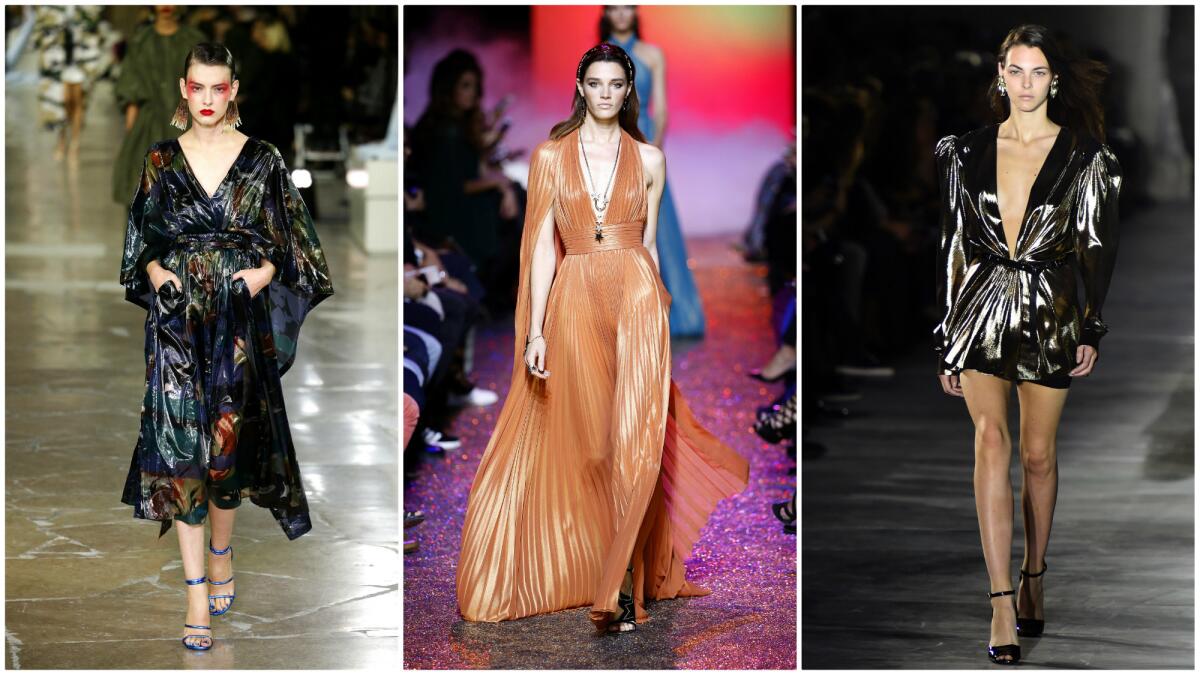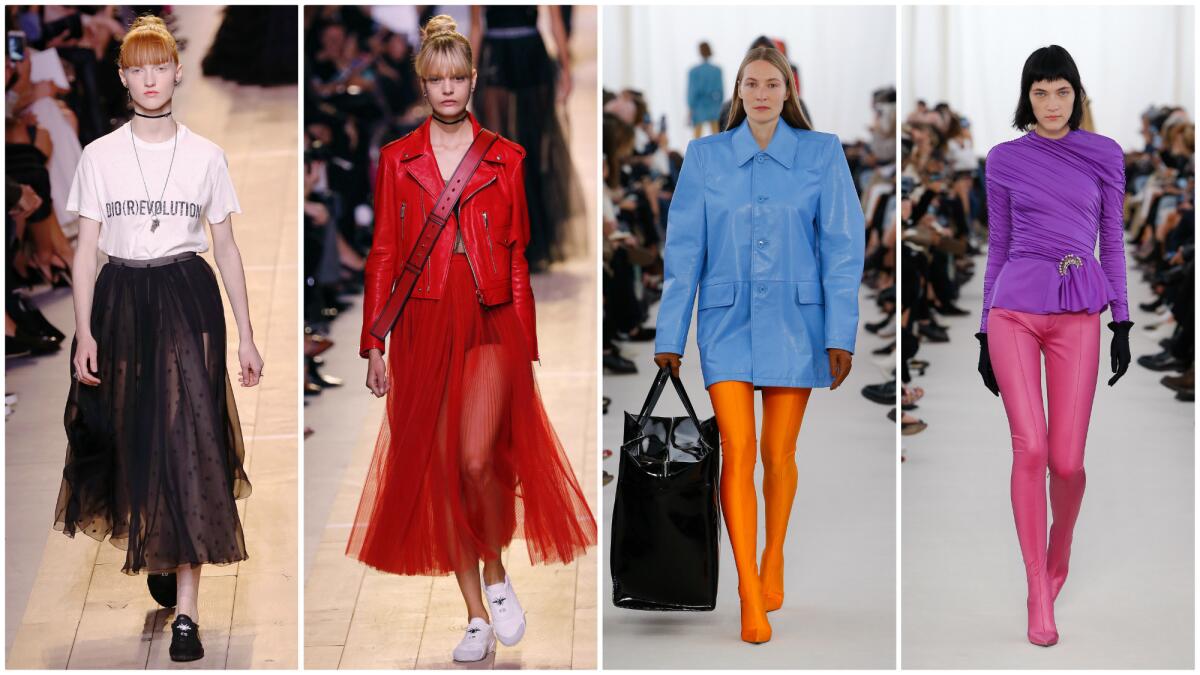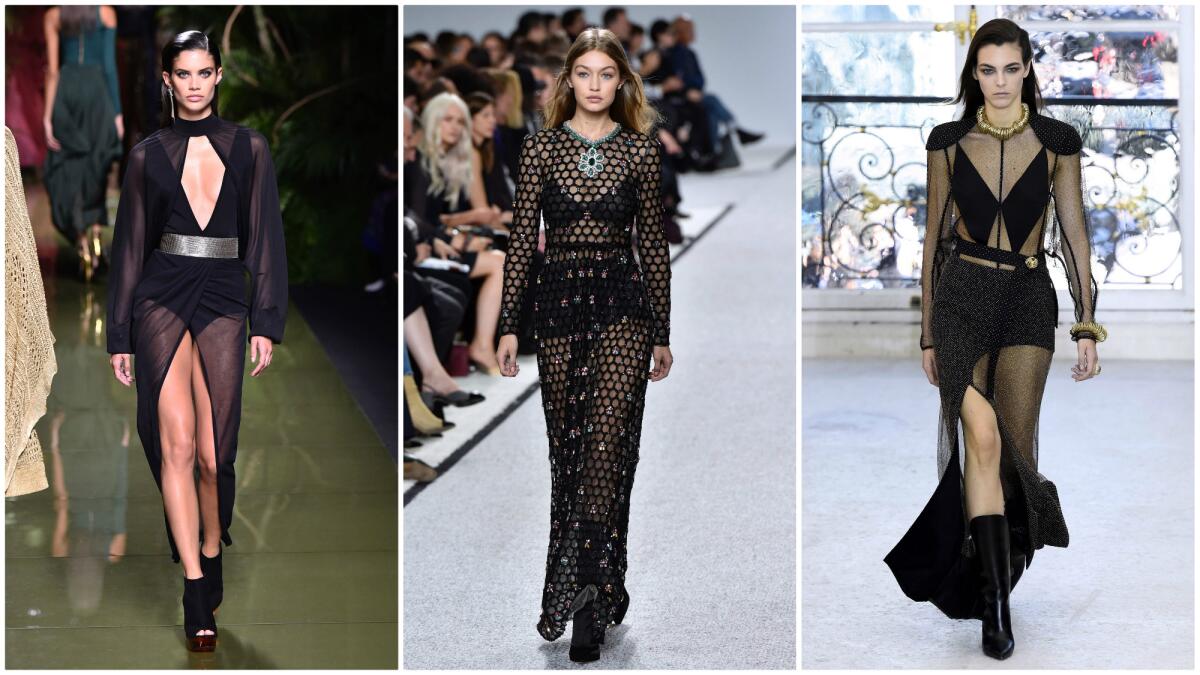Paris Fashion Week meets Studio 54 as disco-inspired fashions boogie down the runways

The collections that came down the catwalks here during Paris Fashion Week may be destined for stores in the spring of 2017, but in many ways, they felt like a four-decade time hop back to 1977, when disco was still king and the push was on for states to ratify the Equal Rights Amendment.
It wasn’t all lighted-floor-appropriate luxe and feminist-focused fashion, mind you, but there were enough references to both over the nine-day run of fashion week in the City of Light to cause serious Me Decade flashbacks.
A return to disco
A late ’70s / early ’80s aesthetic was already evident coming out of the New York shows — the trippy, psychedelic florals at Tory Burch and Michael Kors and the high-waisted, flare-legged trouser silhouette everywhere — but in Paris, the framework shifted noticeably from commune to club, with disco references seen (and heard on show soundtracks) from Anthony Vaccarello’s debut collection for Saint Laurent on Sept. 28 through Nicolas Ghesquière’s Louis Vuitton women’s collection (on the final day of the shows) with swirly metallic mini-dresses with triangular cutouts over the left hip and gold jackets heavy with sequins.

In addition, two of the week’s more memorable collections explicitly referenced the disco era. The first of these was Elie Saab’s “Standing on Stardust” collection which, the show notes explained, was designed to evoke “the golden age of disco.”
That meant ultraglam evening wear in liquid lamé, lots of Lurex, leather and silk mousseline, draped or flowing gowns with capes and high leg slits, low-cut cocktail dresses and, yes, a rainbow of metallics, all sprinkled with sequins and dripping with beaded tassels.
The second was Kenzo, which staged a standout show in le Cite de l’Architecture et du Patrimoine museum under the watchful eye of a dozen or so “living statues” — stone-colored, stock-still set pieces, some nude, others draped in fabric, like ancient Greek statues; some with outsized body parts, others missing appendages.
The living statuary was so unexpected and so hauntingly beautiful, it was in danger of stealing the show. (Kenzo creative directors Carol Lim and Humberto Leon have a way of doing that. The duo presented a recent Opening Ceremony collection at New York Fashion Week as a “pageant of the people” hosted by Fred Armisen and Carrie Brownstein.)
The show notes cite as inspiration a 1977 show Kenzo Takada staged at the famed Studio 54 nightclub for which Grace Jones performed and Jerry Hall hit the catwalk. (What the notes don’t do is make the connection between the nightclub and the living statues — which were apparently a thing at the club famed for its indulgences and excesses.)
The designers had worked with the archives of artist Antonio Lopez, whose photos documented the party scene of the period in New York and Paris (and of which Kenzo had been a part), gridding and collaging his photos onto jackets and skirts.
These were joined by a range Lurex, lamé and denim pieces as well as voluminous caped dresses, jumpsuits and baggy pants gathered at the ankles made using shiny technical taffetas, silvery blue cocktail dresses festooned with paillettes the size of Eisenhower dollars.

Finding feminism
It’s too early to tell if Maria Grazia Chiuri, the first female artistic director in the history of Christian Dior, fired an opening shot in a feminist fashion revolution with her debut collection for the house here on Sept. 30, but she certainly put the notion front and center — literally with T-shirts printed with slogans such as, “We should all be feminists” and “Dio(r)evolution,” paired with black tulle skirts layered over knit underwear.
Many pieces in the collection took inspiration from fencing, a sport in which, as Grazia Chiuri explained, “The uniform of the female fencer is, with the exception of some special protections, the same as for a male fencer.” While you may not be down for wearing a quilted jacket that resembles a fencing vest (right down to the red heart-embroidered applique over the left breast), there was something refreshing about the notion of putting men and women on the same footing fashion-wise, whatever that may ultimately look like.
If your brain immediately went to the place where “feminist fashion” equals “mannish clothes,” you’ve made a logical misstep wider than the whaleboned jacket shoulders in Balenciaga’s spring/summer 2017 collection, which, in exploring the connection between couture and fetishism, ended up with a look that was equal parts serious business and sexy as all get out — strong-shouldered jackets up top and curve-hugging Spandex from hip to stiletto tip.
Looks that were powerful and powerfully feminine could be seen everywhere at Paris Fashion Week, including Balmain, where Olivier Rousteing declared that his Balmain army had “shed its armor” — but replaced it with something more akin to chain mail, in the form of body-hugging knits that simultaneously protected and celebrated the female form.
Rihanna was treading some of the territory (and keying into the athleisure trend at the same time) with the Paris Fashion Week runway debut of her Fenty Puma by Rihanna collaboration. RiRi’s Marie Antoinette-meets-the-street spring/summer 2017 collection was a mash-up of military influences, workout wear and lacy-edged lingerie in a range of colors that included beige and pale shades of purple, green and pink.

Pink is all the rage
Pink turned out to be one of the week’s most notable color trends, from the fetishistic fuchsia Spandex in the aforementioned Balenciaga collection to a statement-making pink coat at Valentino which had fashion editors’ tongues wagging— well, those fortunate to score a seat — to the bits and bytes of Chanel’s “Data Center” collection.
Hermès served up a range of pink pieces from muted workwear-inspired jackets and trousers to a gorgeous fuchsia-hued gown that will no doubt find its way to a Hollywood red carpet in the not-to-distant future.
Feel feminine but not vulnerable
Fabric-wise, expect lace to be all over the place come spring. In addition to edging lingerie-like garments (at Chanel and Fenty Puma by Rihanna) in traditional shades, lace appeared in camouflage-patterned military-style jackets (Sacai), full-length black dresses (Giambattista Valli) and an electric blue head-to-toe trouser-and-sleeveless-top look at Louis Vuitton.
The high-point of the lace race came with the Alexander McQueen collection, which drew inspiration from the lace work of the Shetland Islands and included a series of tiered lace dresses with frayed edges that had been woven with intricate designs including flowers, shells, spider webs and ocean waves.

But with few exceptions, the lacy hardly meant racy, and the magical, strong-shouldered women at Alexander McQueen were as protected for battle as Balmain’s soft-armored woman.
It was tulle and sheer netting — lots and lots of both — that seemed to be everywhere this season yet covered up next to nothing. Modesty required that the black tulle skirts and embroidered tulle dresses worn by Dior’s budding feminist posse be worn with some sort of foundation garment. Ditto for the Louis Vuitton dresses that, despite having full sleeves and and a hem that fell to the ankles, showed as much skin as the swimsuits on the Miu Miu runway.

One thing is for certain: There will be no shortage of options for women who want to feel feminine but not vulnerable come next spring. And that timetable is noteworthy too. Unlike the labels at New York Fashion Week leaping headlong into the “see-now / buy-now” arena, the luxury brands showing in Paris were sticking to the traditional timetable of showing clothes that are still five to six months away from retail. (The one exception was Andreas Kronthaler for Vivienne Westwood, which made a capsule collection of select runway pieces available immediately afterward; the show notes described it as a way to celebrate Westwood’s new Paris boutique.)
In a weird way, that means that the Paris Fashion Week time machine only worked in one direction, with a 40-year backward inspirational leap proving infinitely easier than a tiny five-month retail hop forward.
For more musings on all things fashion and style, follow me @ARTschorn.
ALSO
Jacquemus, Saint Laurent showcase the strong shoulder
Maria Grazia Chiuri’s Dior debut touches on fencing and feminism
Paris Fashion Week’s most spotted celebrities include Courtney Love and … Steve Harvey




